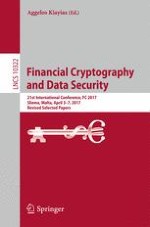This book constitutes the thoroughly refereed post-conference proceedings of the 21st International Conference on Financial Cryptography and Data Security, FC 2017, held in Sliema, Malta, in April 2017.
The 30 revised full papers and 5 short papers were carefully selected and reviewed from 132 submissions. The papers are grouped in the following topical sections: Privacy and Identity Management; Privacy and Data Processing; Cryptographic Primitives and API's; Vulnerabilities and Exploits; Blockchain Technology; Security of Internet Protocols; Blind signatures; Searching and Processing Private Data; Secure Channel Protocols; and Privacy in Data Storage and Retrieval.
